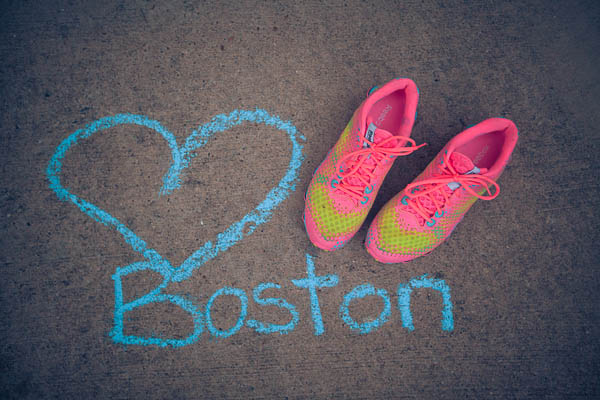
Anniversaries Can be Difficult
Today marks the one-year anniversary of the Boston Marathon bombings and it has been difficult to avoid the media coverage. Most of my news comes from the radio and I've had to turn it off a few times when I didn't want my daughter to hear the details of who was killed, which survivors lost limbs, or whether the victims support the death penalty for the accused bomber, who is awaiting trial at a federal prison about ten miles from our house.
We're always especially careful when watching the news on TV or our computers to make sure she doesn't see disturbing or gruesome images, but we can't prevent her from hearing about public tragedies from her friends in the neighborhood or at school. So when there are tragic events in the news, we're even more vigilant about checking in with her and making sure that she is okay.
Tips for Handling Trauma with Kids
I've done a lot of reading on trauma (for a lay-person) and how it affects kids. There are many resources for parents wondering how to talk to their children when these tragic events occur. Some of the best are the American Psychological Association, the Mayo Clinic, and PBS Parents. Here are my takeaways:
Turn Off the TV
The youngest children (preschoolers) can think that the images they see are new events. When they see bombs again and again, they might not realize they are looking at video of the same incident. Older children quite likely will find the images disturbing and difficult to forget. It can be difficult to tear yourself away from the news, but do it. If an older child insists on watching the news about an event, watch it with her or him, discuss it and then turn off the TV.
Stress Safety
Reassure children they are safe. Providing extra comfort and sticking to routines can help with younger children. Give your child extra comfort, especially at bedtime, which can be especially lonely and scary. Encourage questions which will be indicators of what your child is afraid of or worried about. They might ask the same questions over and over– that's ok, keep answering them. With older children sometimes statistics which demonstrate the actual rarity of these events can help. Do not give false reassurances, which children are quick to see through. Don't say, "That could never happen here." Rather, focus on the efforts you, school personnel, and others (such as police), make to keep all children safe.
Tell the Truth
Always answer questions truthfully. This goes for all ages. The foundation of security is trust and truth is the foundation of trust. This doesn't mean tell all– I think the same approach that we've all heard about sex ed (answer the questions asked, but don't give more information than the child asks) applies here. If your child asks what happened, give the simplest, age-appropriate answer and wait for the next question. And listen, listen, listen. Let your children talk as much as they need to talk– many children process scary events by talking about them over and over. This can be in the form of questions, statements, or even story-telling.
Stay Calm and Protect Yourself
Many experts use the airplane oxygen masks analogy; you need to protect yourself, physically and emotionally, to be there for your children. This can mean that you stop Googling the latest updates or turn off the radio. It also means making sure you are rested and taking care of yourself so you have emotional strength and patience.
Watch for Signs of Stress, Fear and Anxiety
Some children may become anxious or fearful after a public tragedy, especially children who have experienced trauma in their own lives. Some signs include trouble sleeping, difficulty in school, physical complaints or change in appetite, decreased interest in usual activities or friendships. If you see these signs, consider consulting with a professional for guidance to help your child.
Resilience and Hope
Emphasize the positive with your children– help them to see the good in people. After the bombings last year, many people were quoting Fred Rogers, who said: "When I was a boy and would see scary things in the news, my mother always said to me, "Look for the helpers. You will always find people who are helping." The Boston Marathon bombings provided many runners, spectators, and race staff with a choice to flee or stay and help. Many chose to run toward the blasts to help those too injured or stunned to help themselves.
Emphasize the Positive
The extraordinary and heroic efforts of these folks, and all the first responders who were on the scene or nearby, surely saved many lives. All the injured (save the three souls who died at the scene) were moved within minutes to the medical tent or hospitals for treatment after the blasts, and all of them survived. This incredible response is a tribute to the compassion of humans for one another and should provide hope and inspiration to children and adults alike. Much of the recent media attention around the anniversary of the bombings has focused on the resilience of the survivors.
Many of them are truly inspirational, and great lessons for school-age children and adolescents. (Children younger than about ten years old may be too little for some of the story content and especially post-injury images of survivors.) If you haven't seen the video of Adrianne Haslet-Davis dancing on her specially-designed prosthetic leg, please check it out below. Adrianne, 33, is a dancer who lost her left leg in the Boston Marathon bombings last year.
Only a week later, she vowed to dance again, and now she is, after spending months at MIT's Media Lab with Hugh Herr, director of biomechatronics. The team at MIT studied dancers' movements and developed a unique prosthetic leg which could respond to the irregular and nuanced movements of a dancer. Adrianne danced publicly for the first time at a TED Talk. Her journey has been long and difficult, and she admits to moments of fear and despair, which are chronicled in her video diary as part of a profile by CNN and Anderson Cooper.
Acknowledge Loss
Tragically, a child, Martin Richard, was killed by one of the Boston Marathon bombs. His sister Jane lost her leg and both parents were injured. The entire family (including older brother Henry) has struggled deeply in the wake of this tragedy– Jane endured multiple surgeries and learned to walk on her artificial limb, while all have dealt with the loss of a beloved family member. Jane's determination and resilience in the face of these emotional and physical challenges have been an inspiration to her family and all who have witnessed her remarkable accomplishments.
Look for Ways to Help
The Richard family has created the Martin W. Richard Charitable Foundation to honor Martin's memory and 100 runners will race the Boston Marathon next Tuesday to raise money for education, athletics, and community. The numbers of runners and spectators anticipated for the 2014 race on April 21st are also signs of this resilience. There are 36,000 runners registered, an increase of 9,000 from last year, and race officials anticipate double the usual number of spectators–for a total of 1,000,000. Despite the increased security (no backpacks allowed), traffic, and parking difficulties, we'll be there next week.
For the first time in several years, we'll be there to swell the numbers by three in support of of all those running for charities, and to show our daughter the awesome power of a million people united in demonstrating resilience and hope. She'll learn exactly what it means to be Boston Strong.
By Liz Smith. Liz has worked across the globe for many of the world's best known apparel brands, including Justice, Chico's, Victoria's Secret, and Hanes. She has worked closely with dozens of factories in more than 20 countries to ensure that production is of the highest standard. Liz has managed all aspects of garment production, from design through fabric development to sewing and merchandising - so she knows what it takes to make high-quality apparel. Liz is thrilled to share her knowledge about clothes to help discerning customers choose the finest products.

